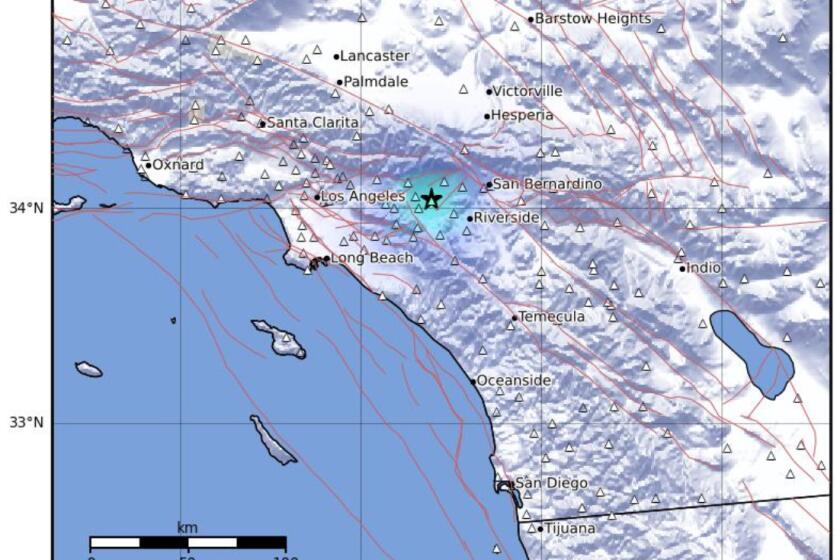Earthquake Preparedness: Shakedown for the Shake-Up
First, the good news: The earth will not, repeat, will not, “yawn open, swallow down whole neighborhoods and slam shut again” if a major earthquake strikes.
Now, the bad news: The Big One, in case you had doubts, is on its way and probably will rumble through Southern California within 30 years. So predicts Clarence Allen, head geologist at Caltech in Pasadena and an expert on such matters.
How to deal with the Big One was the topic this week for a group of American Honda Motor Co. workers at the Carson plant. The meeting coincided with Earthquake Preparedness Week, declared by state, Los Angeles County and city officials.
It preceded by three days the appearance of the “Quakey-Shakey” van in Redondo Beach. The Los Angeles County Fire Department vehicle, which is equipped with a hydraulic system that simulates the feel of an earthquake, will tour the city’s elementary schools Friday.
Sure, talking about temblors is as common in California as talking about twisters in Topeka, hurricanes in Florida or floods along the Mississippi. After all, about 5,000 “feeble but feelable” earthquakes are recorded statewide every year, according to the booklet “Earthquake Preparedness,” which was distributed at the meeting.
Nevertheless, the 80 or so workers, including Tetsuo Chino, president of American Honda, listened intently as Allen and Libby Lafferty, a disaster preparedness training expert and author of the booklet, addressed them. They also watched a slide show titled, appropriately, “Shake, Rattle and Roll.”
As one might expect, some definite do’s and don’ts emerged during the two-hour session. A few examples:
- Stay calm. “Take a deep breath and allow your heart to slide back down out of your throat,” Lafferty advised. “You can scream and yell, pray or count to 100. Pretty soon the earth will stop shaking.”
- Pick a place in your home to serve as a shelter, and do it well before the quake. “Being rudely awakened at 3 a.m. in the pitch dark is not the time to think about where that place is,” Lafferty said.
- If at work, don’t pick the same place as the worker sitting next to you. “It would be a good idea to talk to that person before each decided you were going to go under the same desk,” she cautioned.
- If you have taken refuge under furniture and that furniture starts to move, move with it. “Stay under it and follow it around the room,” the booklet states.
- If you are in your car when the earthquake hits--a likely situation for many Southland residents--steer away from bridges and overpasses, stop and stay put. “A car is an excellent shock absorber and will jiggle fearsomely on its springs during an earthquake, but it’s a fairly safe ‘cocoon’ from which to assess your situation,” the booklet continues.
- Stay away from elevators. You could become stranded if there is an electrical failure.
- Store enough food, water and other supplies for at least 72 hours. That is the period that federal, state and local governments have said you may not be able to rely on help from them.
American Honda representatives said the firm is preparing its own earthquake preparedness program. Tony Piazza, the company’s manager for security and safety, said it is coordinating its resources with those of neighboring companies, such as a grocery across the street, and has determined where to locate emergency supplies such as water.
“We know where every bottle of Sparkletts water is located here,” Piazza said. He added that if gasoline is needed, there will be plenty. “We have plenty of cars.”
Several employees said afterward that they would try to heed the advice in the booklet and prepare their homes and families for a major earthquake. Employee Steven Smith, a parts department supervisor, said his family has an emergency supply of food because his wife belongs to the Mormon Church, which requires members to keep such a supply.
But Smith seemed more preoccupied with what might happen at work if a quake hit. The presentation, he said, made him mildly concerned about what would happen to the glass partitions that partly surround his desk.
“It kind of gets your paranoia level up.”
More to Read
Sign up for Essential California
The most important California stories and recommendations in your inbox every morning.
You may occasionally receive promotional content from the Los Angeles Times.










